Study of Ventilation Strategies in a Passenger Aircraft Cabin Using Numerical Simulation
Abstract
1. Introduction
2. Methodology
2.1. CFD Theory
2.2. CFD Modelling and Analysis
3. Results and Discussion
4. Conclusions
Author Contributions
Funding
Data Availability Statement
Acknowledgments
Conflicts of Interest
Nomenclature
| CFD | Computational Fluid Dynamics |
| COVID | Coronavirus Disease |
| DPM | Discrete Phase Modeling |
| H1N1 | Hemagglutinin Type 1 and Neuraminidase Type 1 |
| HEPA | High-Efficiency Particulate Air |
| RNG | Renormalization Group |
| SARS | Severe Acute Respiratory Syndrome |
| SIMPLE | Semi-Implicit Method for Pressure-Linked Equations |
References
- Arblaster, M. The Air Traffic Management Industry. In Air Traffic Management; Elsevier: Amsterdam, The Netherlands, 2018; pp. 1–8. [Google Scholar]
- Dechow, M.; Sohn, H.; Steinhanses, J. Concentrations of Selected Contaminants in Cabin Air of Airbus Aircrafts. Chemosphere 1997, 35, 21–31. [Google Scholar] [CrossRef] [PubMed]
- The Airliner Cabin Environment and the Health of Passengers and Crew; National Academies Press: Washington, DC, USA, 2002; ISBN 978-0-309-08289-1.
- Zubair, M.; Ahmad, K.A.; Riazuddin, V.N. A Review on the Impact of Aircraft Cabin Air Quality and Cabin Pressure on Human Wellbeing. Appl. Mech. Mater. 2014, 629, 388–394. [Google Scholar] [CrossRef]
- Moreno, T.; Gibbons, W. Aerosol Transmission of Human Pathogens: From Miasmata to Modern Viral Pandemics and Their Preservation Potential in the Anthropocene Record. Geosci. Front. 2022, 13, 101282. [Google Scholar] [CrossRef] [PubMed]
- Bale, R.; Li, C.; Fukudome, H.; Yumino, S.; Iida, A.; Tsubokura, M. Characterizing Infection Risk in a Restaurant Environment Due to Airborne Diseases Using Discrete Droplet Dispersion Simulations. Heliyon 2023, 9, e20540. [Google Scholar] [CrossRef]
- Olsen, S.J.; Chang, H.-L.; Cheung, T.Y.-Y.; Tang, A.F.-Y.; Fisk, T.L.; Ooi, S.P.-L.; Kuo, H.-W.; Jiang, D.D.-S.; Chen, K.-T.; Lando, J.; et al. Transmission of the Severe Acute Respiratory Syndrome on Aircraft. N. Engl. J. Med. 2003, 349, 2416–2422. [Google Scholar] [CrossRef]
- Motamedi Zoka, H.; Moshfeghi, M.; Bordbar, H.; Mirzaei, P.A.; Sheikhnejad, Y. A CFD Approach for Risk Assessment Based on Airborne Pathogen Transmission. Atmosphere 2021, 12, 986. [Google Scholar] [CrossRef]
- Sheikhnejad, Y.; Aghamolaei, R.; Fallahpour, M.; Motamedi, H.; Moshfeghi, M.; Mirzaei, P.A.; Bordbar, H. Airborne and Aerosol Pathogen Transmission Modeling of Respiratory Events in Buildings: An Overview of Computational Fluid Dynamics. Sustain. Cities Soc. 2022, 79, 103704. [Google Scholar] [CrossRef]
- Tsang, T.-W.; Mui, K.-W.; Wong, L.-T. Computational Fluid Dynamics (CFD) Studies on Airborne Transmission in Hospitals: A Review on the Research Approaches and the Challenges. J. Build. Eng. 2023, 63, 105533. [Google Scholar] [CrossRef]
- Feng, K.; Yanagita, Y.; Miyamura, Y.; Basri, A.A.; Zuber, M.; Rohani, S.; Ahmad, K.A.; Tamagawa, M. CFD Analysis of Indoor Ventilation for Airborne Virus Infection. J. Adv. Res. Numer. Heat. Transf. 2023, 14, 1–16. [Google Scholar] [CrossRef]
- Geisler, S.M.; Lausch, K.H.; Hehnen, F.; Schulz, I.; Kertzscher, U.; Kriegel, M.; Paschereit, C.O.; Schimek, S.; Hasirci, Ü.; Brockmann, G.; et al. Comparing Strategies for the Mitigation of SARS-CoV-2 Airborne Infection Risk in Tiered Auditorium Venues. Commun. Eng. 2024, 3, 161. [Google Scholar] [CrossRef]
- Sun, Y.; Zhang, Y.; Wang, A.; Topmiller, J.L.; Bennet, J.S. Experimental Characterization of Airflows in Aircraft Cabins, Part 1: Experimental System and Measurement Procedure. In Proceedings of the ASHRAE Transactions; ASHRAE: Peachtree Corners, GA, USA, 2005; Volume 111, pp. 45–52. [Google Scholar]
- Yan, W.; Zhang, Y.; Sun, Y.; Li, D. Experimental and CFD Study of Unsteady Airborne Pollutant Transport within an Aircraft Cabin Mock-Up. Build. Environ. 2009, 44, 34–43. [Google Scholar] [CrossRef]
- Mangili, A.; Gendreau, M.A. Transmission of Infectious Diseases during Commercial Air Travel. Lancet 2005, 365, 989–996. [Google Scholar] [CrossRef] [PubMed]
- Gao, N.; Niu, J. Transient CFD Simulation of the Respiration Process and Inter-Person Exposure Assessment. Build. Environ. 2006, 41, 1214–1222. [Google Scholar] [CrossRef]
- Grossi, G.; Arpino, F.; Buonanno, G.; Cortellessa, G.; Moretti, L.; Nagano, H.; Stabile, L. A Eulerian-Lagrangian Approach for the CFD Analysis of Airborne Disease Transmission in a Car Cabin. J. Phys. Conf. Ser. 2022, 2177, 012015. [Google Scholar] [CrossRef]
- Vita, G.; Woolf, D.; Avery-Hickmott, T.; Rowsell, R. A CFD-Based Framework to Assess Airborne Infection Risk in Buildings. Build. Environ. 2023, 233, 110099. [Google Scholar] [CrossRef]
- Aboosaidi, F.; Warfield, M.J.; Choudhury, D. Computational Fluid Dynamics Applications in Airplane Cabin Ventilation System Design. SAE Technical Paper, 1 September 1991. [Google Scholar]
- Yoo, S.-J.; Yamauchi, S.; Park, H.; Ito, K. Computational Fluid and Particle Dynamics Analyses for Prediction of Airborne Infection/Spread Risks in Highway Buses: A Parametric Study. Fluids 2023, 8, 253. [Google Scholar] [CrossRef]
- Ko, G.; Thompson, K.M.; Nardell, E.A. Estimation of Tuberculosis Risk on a Commercial Airliner. Risk Anal. 2004, 24, 379–388. [Google Scholar] [CrossRef]
- Gupta, J.K.; Lin, C.-H.; Chen, Q. Flow Dynamics and Characterization of a Cough. Indoor Air 2009, 19, 517–525. [Google Scholar] [CrossRef]
- Han, Z.Y.; Weng, W.G.; Huang, Q.Y. Characterizations of Particle Size Distribution of the Droplets Exhaled by Sneeze. J. R. Soc. Interface 2013, 10, 20130560. [Google Scholar] [CrossRef]
- Ansys, I. ANSYS Fluent Theory Guide, Ansys; Ansys Inc.: Canonsburg, PA, USA, 2012. [Google Scholar]
- Singh, A.; Hosni, M.H.; Horstman, R.; Van Gilder, J.; May, R. Numerical Simulation of Airflow in an Aircraft Cabin Section. ASHRAE Trans. 2002, 108, 1005–1013. [Google Scholar]
- Mazumdar, S.; Chen, Q. Influence of Cabin Conditions on Placement and Response of Contaminant Detection Sensors in a Commercial Aircraft. J. Environ. Monit. 2008, 10, 71–81. [Google Scholar] [CrossRef] [PubMed]
- Khalil, E.E.; Kotb, H. Numerical Simulation of Airflow and Airborne Pathogen Transport in Aircraft Cabins: Dynamic Mesh Analyses. In Proceedings of the AIAA SciTech Forum, Orlando, FL, USA, 6–10 January 2020; pp. 1934–2020. [Google Scholar]
- Kühn, M.; Bosbach, J.; Wagner, C. Experimental Parametric Study of Forced and Mixed Convection in a Passenger Aircraft Cabin Mock-Up. Build. Environ. 2009, 44, 961–970. [Google Scholar] [CrossRef]
- The Airliner Cabin Environment; National Academies Press: Washington, DC, USA, 1986; ISBN 978-0-309-03690-0.
- Tuberculosis and Air Travel Guidelines for Prevention and Control; WHO: Geneva, Switzerland, 2008.
- Neu, J.C.; Carpio, A.; Bonilla, L.L. Theory of Surface Deposition from Boundary Layers Containing Condensable Vapour and Particles. J. Fluid. Mech. 2009, 626, 183–210. [Google Scholar] [CrossRef]
- Riazuddin, V.N.; Zubair, M.; Ahmadi, M.; Tamagawa, M.; Rashid, N.H.A.; Mazlan, N.; Ahmad, K.A. Computational Fluid Dynamics Study of Airflow and Microparticle Deposition in a Constricted Pharyngeal Section Representing Obstructive Sleep Apnea Disease. J. Med. Imaging Health Inform. 2016, 6, 1507–1512. [Google Scholar] [CrossRef]

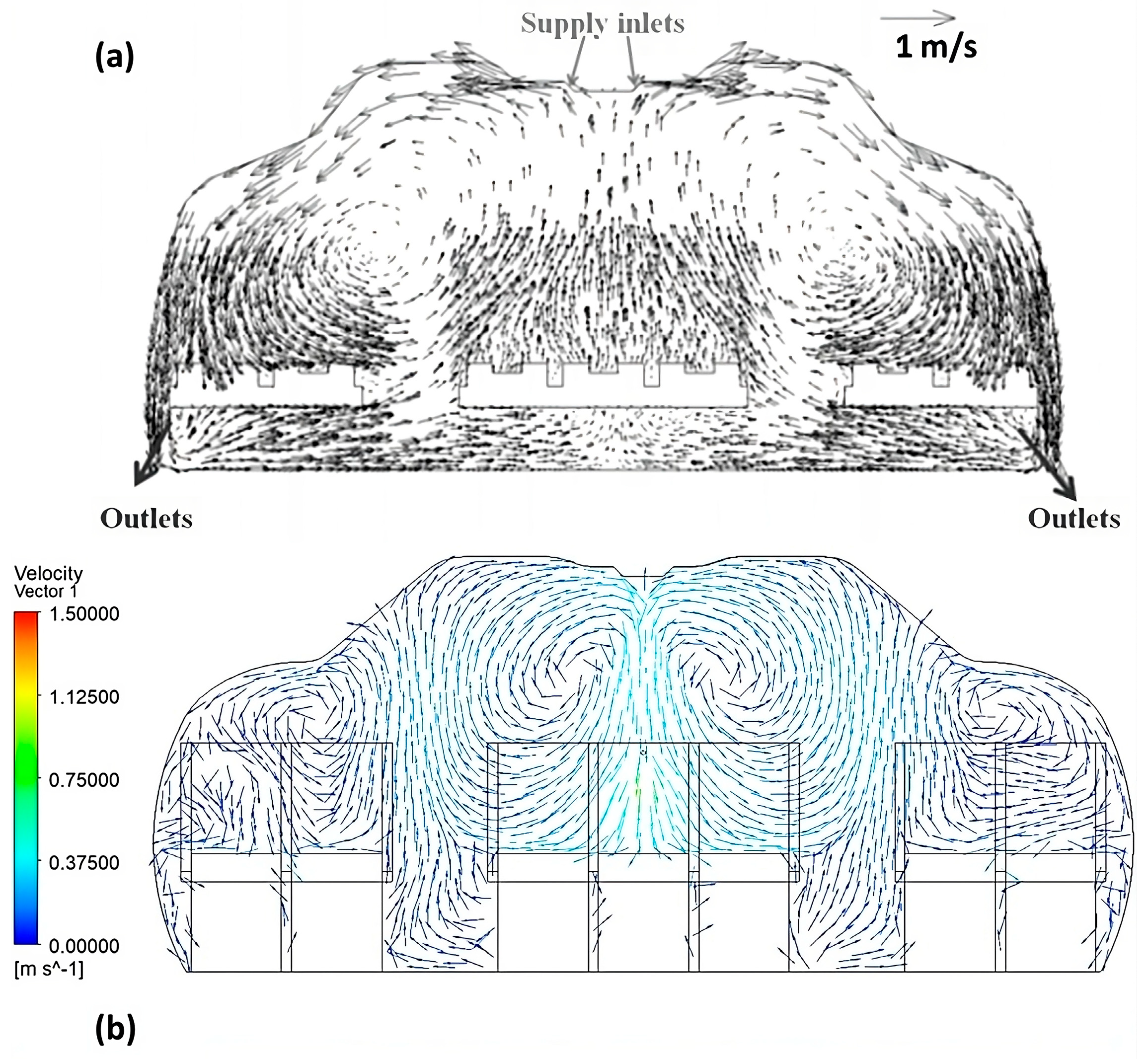
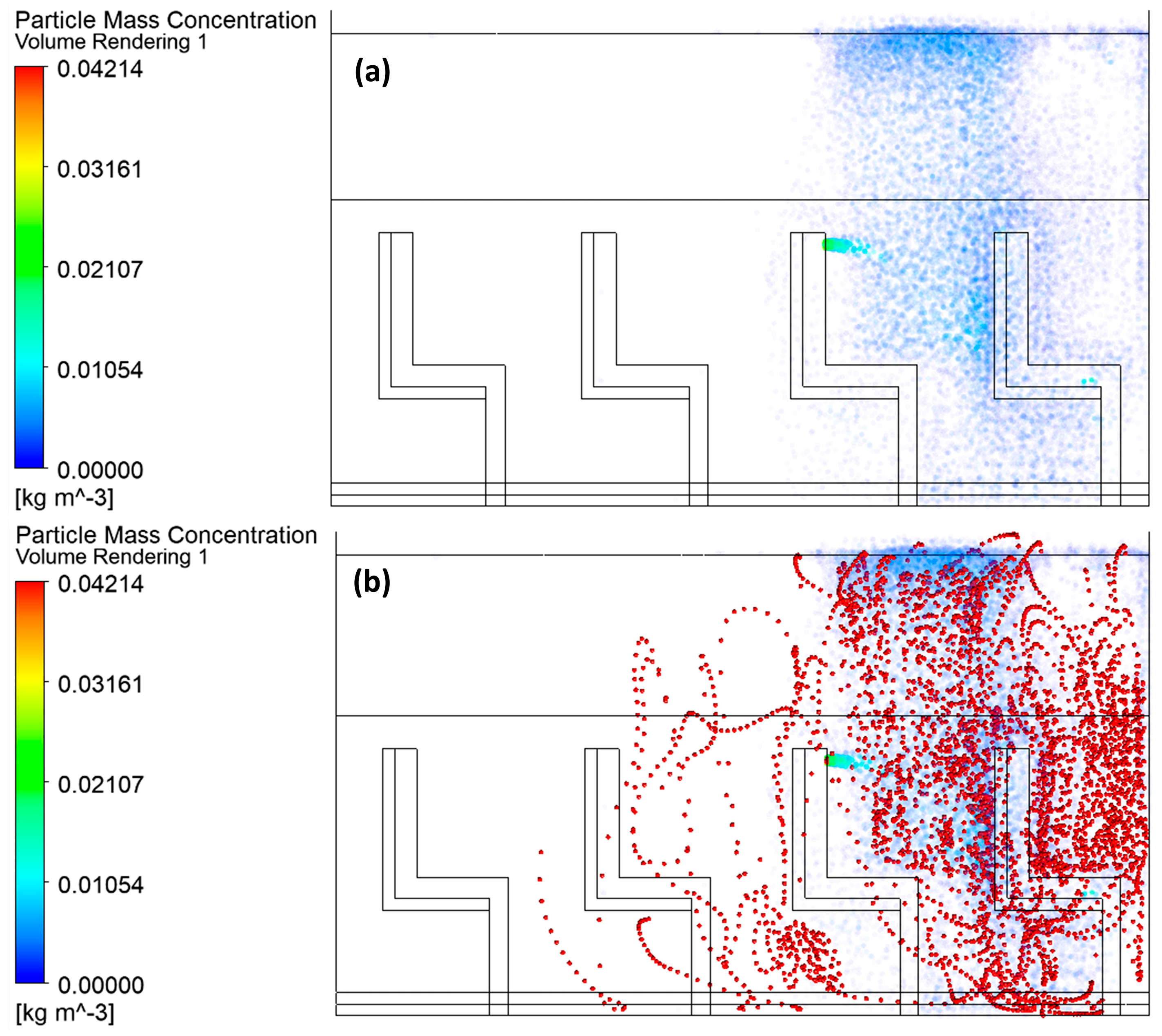
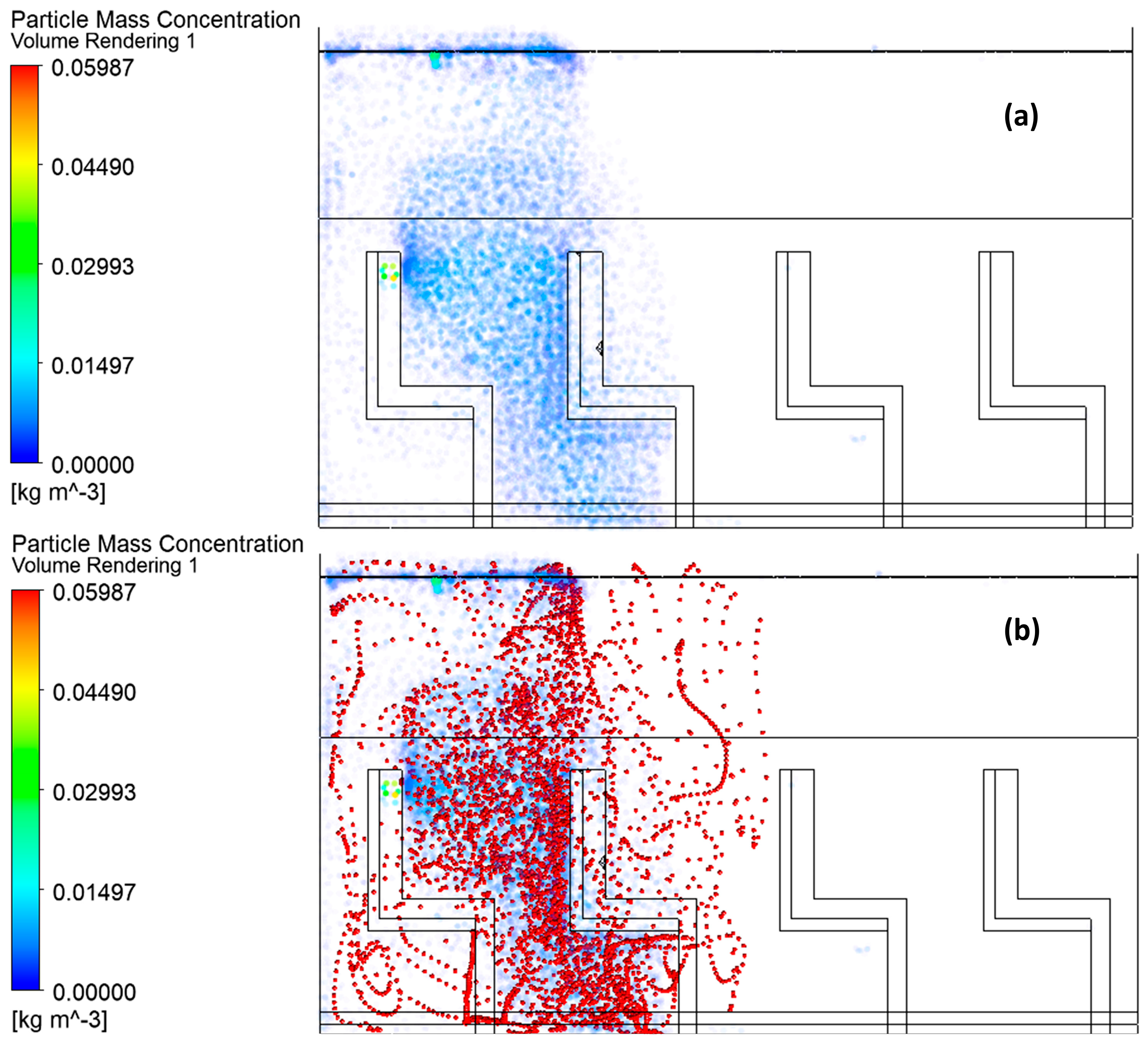
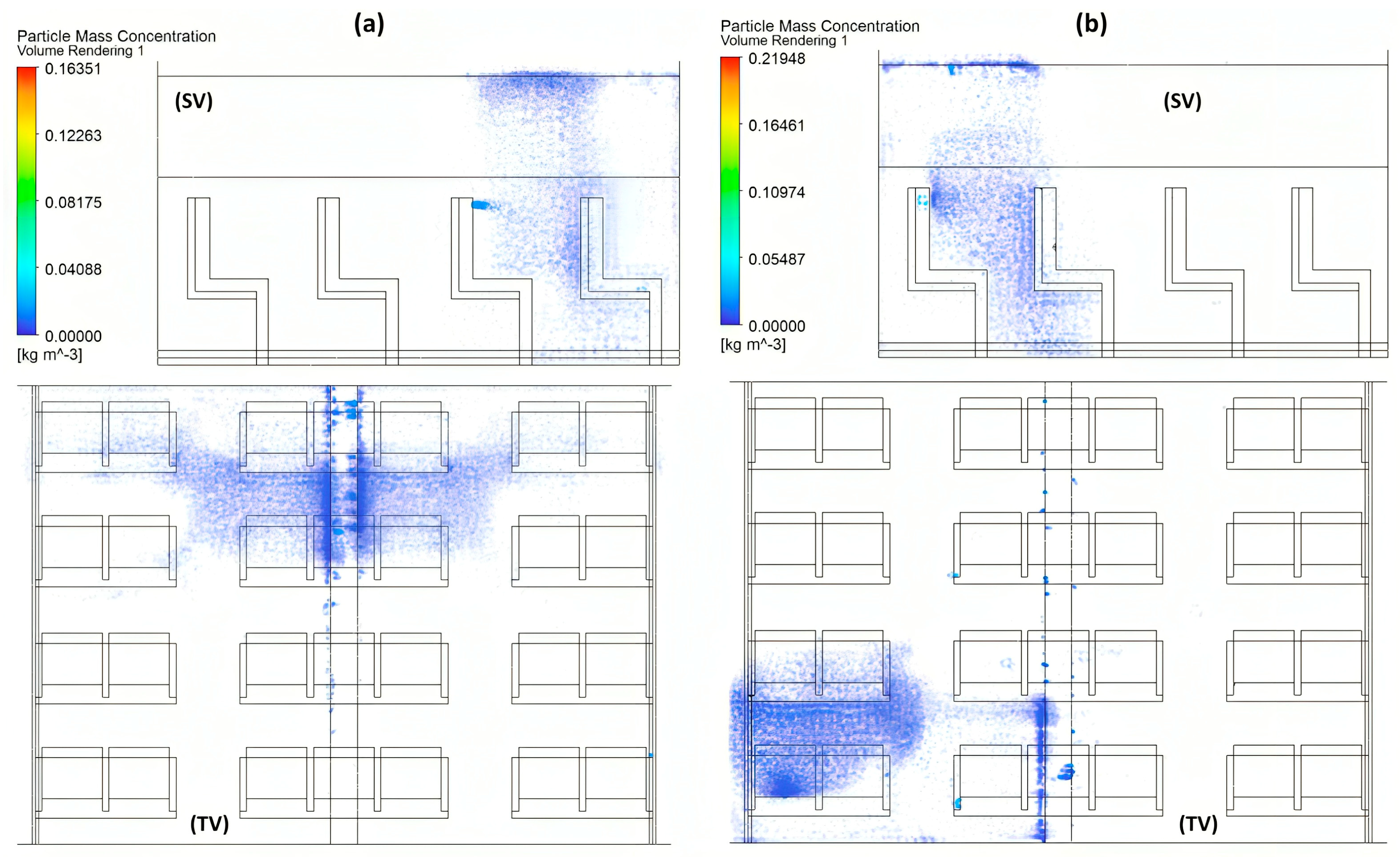
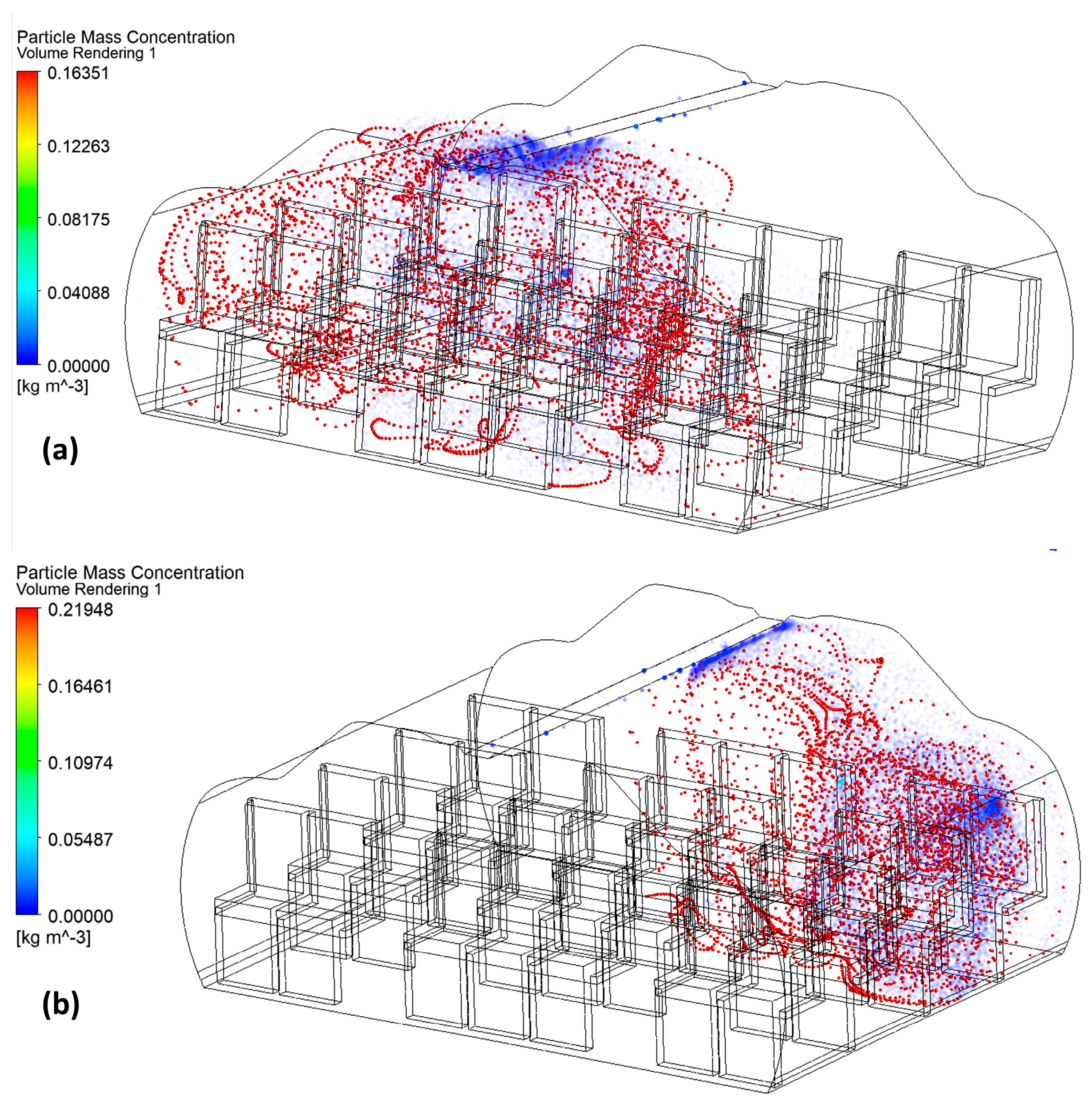
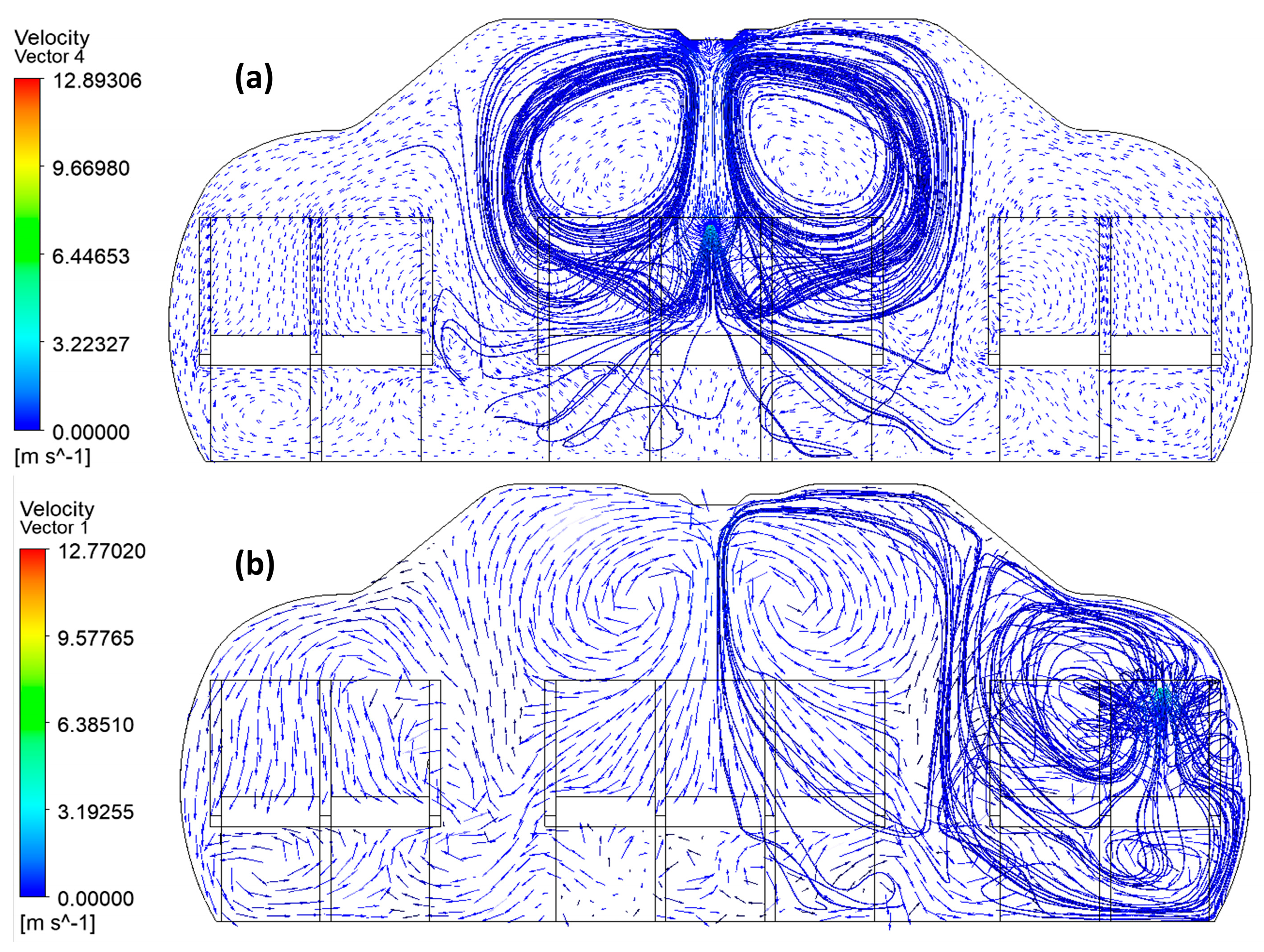

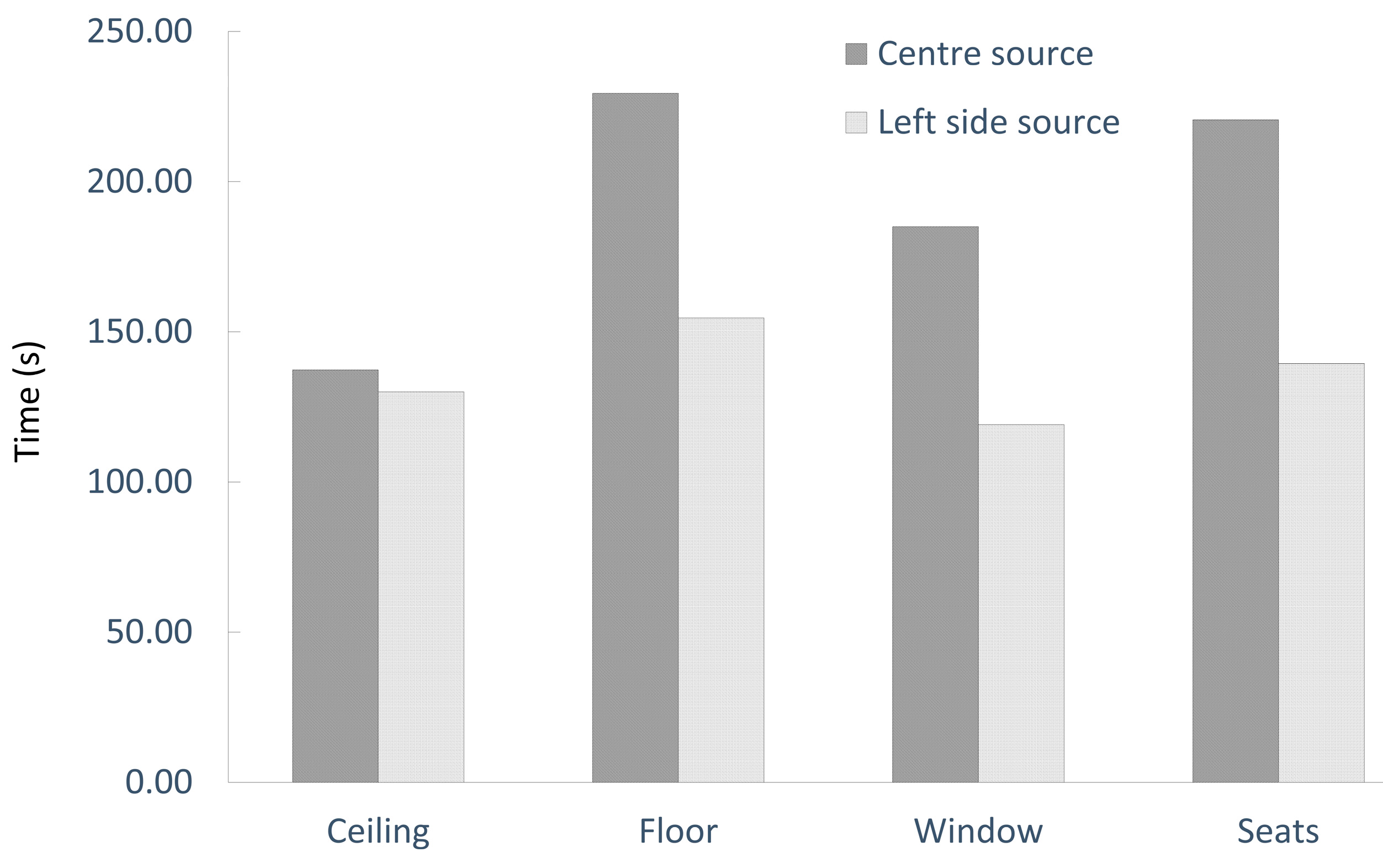
Disclaimer/Publisher’s Note: The statements, opinions and data contained in all publications are solely those of the individual author(s) and contributor(s) and not of MDPI and/or the editor(s). MDPI and/or the editor(s) disclaim responsibility for any injury to people or property resulting from any ideas, methods, instructions or products referred to in the content. |
© 2024 by the authors. Licensee MDPI, Basel, Switzerland. This article is an open access article distributed under the terms and conditions of the Creative Commons Attribution (CC BY) license (https://creativecommons.org/licenses/by/4.0/).
Share and Cite
Khader, S.M.A.; Corda, J.V.; Mathias, K.A.; Shenoy, G.; bin Ahmad, K.A.; Barboza, A.V.; Kamath, S.G.; Zuber, M. Study of Ventilation Strategies in a Passenger Aircraft Cabin Using Numerical Simulation. Computation 2025, 13, 1. https://doi.org/10.3390/computation13010001
Khader SMA, Corda JV, Mathias KA, Shenoy G, bin Ahmad KA, Barboza AV, Kamath SG, Zuber M. Study of Ventilation Strategies in a Passenger Aircraft Cabin Using Numerical Simulation. Computation. 2025; 13(1):1. https://doi.org/10.3390/computation13010001
Chicago/Turabian StyleKhader, S. M. Abdul, John Valerian Corda, Kevin Amith Mathias, Gowrava Shenoy, Kamarul Arifin bin Ahmad, Augustine V. Barboza, Sevagur Ganesh Kamath, and Mohammad Zuber. 2025. "Study of Ventilation Strategies in a Passenger Aircraft Cabin Using Numerical Simulation" Computation 13, no. 1: 1. https://doi.org/10.3390/computation13010001
APA StyleKhader, S. M. A., Corda, J. V., Mathias, K. A., Shenoy, G., bin Ahmad, K. A., Barboza, A. V., Kamath, S. G., & Zuber, M. (2025). Study of Ventilation Strategies in a Passenger Aircraft Cabin Using Numerical Simulation. Computation, 13(1), 1. https://doi.org/10.3390/computation13010001









